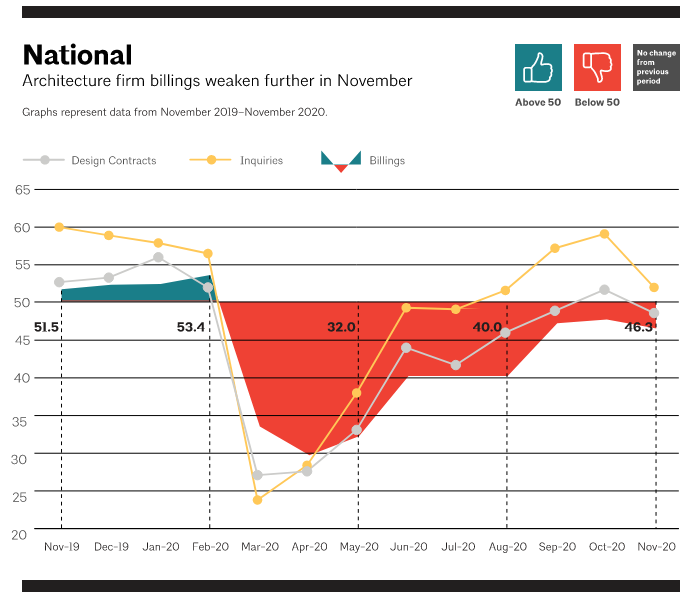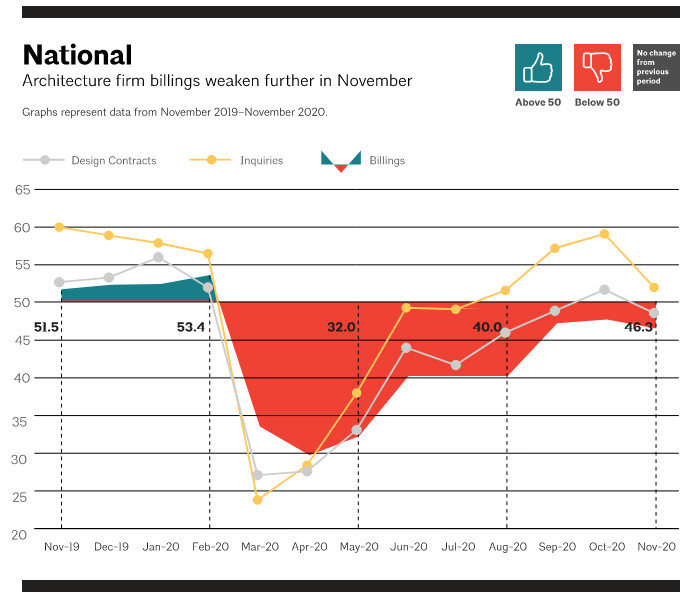
While reading the AIA recently released "Firm Survey Report 2020[i]" and the November "Architecture Billing Index[ii]" (ABI), there were two corollary findings. First, the Firm Survey reported a decrease in profitability for 2019. The ABI reported the top business concern for 29% of firms for 2021 is increasing firm profitability.
Since March 2020, the ABI has showed a decreased billing activity. While there was a glimmer of hope that the billings would cross 50 after October to show growth, November turned more negative. Considering the Firm Survey reports results for 2019 and does not account for the COVID effect. The ABI shows profitability is top‑of‑mind for many firms and may be even more so until ABI moves positive.

Source: https://www.aia.org/resources/10046-architecture-billings-index-abi
Conspectus is normally engaged by architectural firms as the project specifier. We work behind the scenes watching the design develop. From our vantage point, we see several areas where architectural firms can influence their profitability, positively - budget management and decision management.
Budgets
When starting a project, we ask about the project budget. The budget gives a clue about the project quality the owner expects. Often, the budget is not provided. The AIA Standard Owner - Architect agreement requires the architect to prepare a preliminary evaluation of the owner's program, schedule, and budget.[i]" The question is, "Does the architect know the budget, and did the architect confirm the budget aligns with the owner's expectations?"
From the Firm Survey, only 18% of architectural firms have cost estimating staff. Therefore, the next question is, "Who is preparing this preliminary evaluation?" Did the firm hire an independent conceptual estimator to analyze the owner's budget against the program? When we receive an estimate, it is usually prepared by a contractor engaged for preconstruction services, not the architect.
Is the architect at risk by proceeding to design a project that cannot be built for the available budget? We believe that the high frequency of Value Engineering (VE) exercises among and within all Conspectus's projects attests that the answer is YES. Nearly all projects experience VE today. Each VE exercise costs both the architect, and more especially the owner, time and money.
The architect is required to prepare an estimate of the cost of the work as a Schematic Design Phase Deliverable.[ii] The Architect's estimate must be updated and presented to the owner as a deliverable for the Design Development Phase and the Construction Documents Phase.
Unfortunately, the architect may be required to provide redesign at no cost to the owner when the project estimate exceeds the budget.[iii] These VE exercises drain the architect's profit margins (due to increased staff time) and negatively affect the owner's internal rate of return (due to delayed construction starts).
Decisions
Architectural firms use a variety of means to communicate and record design decisions. That variety presents challenges because the entire team may not be privy to all the available information. What is more, the information is fragmented by the distinct design deliverables. This creates gaps where vital information may be compromised, or lost completely because the task is to complete the deliverable rather than build a continuous project record.
We see the variety – email, basis of design, narratives, meeting minutes, design presentations, renderings, and drawings. Each mode contributes, but none is comprehensive. The team is left to piece together the relevant portions of each. This presents a difficulty. What is recorded one place may contradict another. What is the truth? As each team member pieces the information together, a different "truth" may result.
Complete, accurate information is essential to make well-informed design decisions. When vital information is missing, resulting decisions may be erroneous. Erroneous decisions lead to rework when finally discovered. Generally the later discovered, the more rework is required. Rework also robs firms of profit margin due to increased staff time.
The Solution
Budgets: Start at the beginning. Engage an independent ASPE certified professional estimator. Consider this step as part of the GO-NO GO decision process of responding to an owner's request for proposal. Knowing the owner's budget is unrealistic may open opportunities to propose alternative solutions – phased construction for instance – to ensure the project's success.
Embrace continuous estimating. Accurately record design decisions as the estimate basis in fact to validate the costs and budget compliance at every step along the way.
Decisions: Open the specifications black box with Conspectus Cloud. Document owner project requirements and the design response. Share the development, continuously, with the entire project team including the owner and contractor. Identify options to explore. Openly discuss the content to inform decisions. Comparatively analyze options before drawings to ensure the overall performance and costs remain on target with the owner's expectations. Record decisions, as they occur to build the project history.
Plan, plan, and plan some more. Then draw to implement the confirmed decisions.
[i] Firm Survey Report 2020, "The Business of Architecture 2020," The American Institute of Architects, 2020 https://www.aia.org/resources/6151-firm-survey-report
[ii] Architecture Billings Index (ABI), The American Institute of Architects, November 2020, https://www.aia.org/resources/10046-architecture-billings-index-abi
[i] AIA Document B101™ - "Standard Form of Agreement Between Owner and Architect," The American Institute of Architects, 2017, §3.2.2 Schematic Design Phase Services.
[ii] Ibid, §3.2.6 Schematic Design Phase Services.
[iii] Ibid, §6.7 Cost of the Work.
